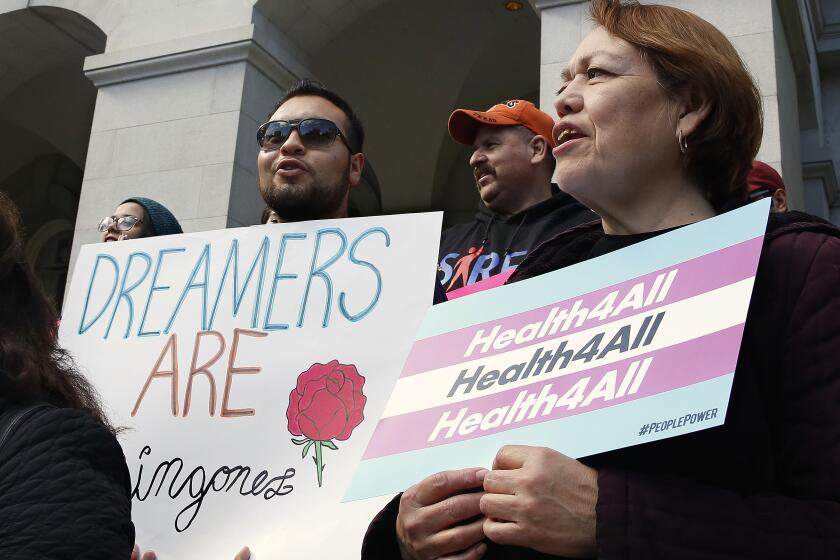Stopping the churn: California and other states want to guarantee Medicaid for kids

- Share via
Before the COVID-19 public health emergency began in 2020, millions of children churned on and off Medicaid each year — an indication that many were losing coverage due to administrative problems, rather than because changes in their family’s income had made them ineligible.
But California and other Western states are seeking to change that with new continuous-enrollment policies for the youngest Medicaid members.
California lawmakers have approved a proposal for children who qualify for Medicaid to be enrolled at birth and stay enrolled until age 5. If the plan receives federal approval, it would go into effect in 2025.
Oregon has already secured approval for a similar policy. In 2023, when the public health emergency is expected to end, Oregon will become the first state to allow children to be enrolled in Medicaid at birth and keep their coverage until they turn 6, regardless of changes in their household’s income and without having to reapply.
“This is really a no-brainer in terms of supporting kids,” said Jenifer Wagley, executive director of Our Children Oregon, an advocacy group. She said that keeping children insured — particularly at the youngest ages, when their bodies and minds are still developing — will ensure they don’t miss important checkups and care because of gaps in coverage.
Washington state in July asked the Biden administration for permission to provide continuous coverage to children until age 6, and a decision is likely in the next few weeks. And New Mexico has sought public comment on a plan to keep kids enrolled until age 6 and is expected to seek federal consent later this year.
Nationally, Medicaid enrollment is at a record high after the federal government prohibited states from dropping members during the public health emergency unless they died or moved out of state. That rule has helped push the country’s uninsured rate to a record low.
If the U.S. public health emergency ends, Americans would be vulnerable to a new coronavirus variant that sparks another COVID-19 surge.
Of the nearly 90 million people on Medicaid and the Children’s Health Insurance Program — a federal-state program that covers children in households with incomes above Medicaid eligibility — about 41 million are children. In California, nearly 1.2 million children younger than 5 are covered by Medi-Cal, the state’s Medicaid program.
The California Department of Health Care Services, which oversees Medi-Cal, estimates the policy change would cost $39.1 million in 2025, assuming a January implementation, and $68 million for the 2025-26 fiscal year. The state is still weighing when to seek federal approval.
Mike Odeh, senior director of health for the California advocacy group Children Now, hopes the state moves ahead soon.
“We would rather see the state pay for kids getting care than paying for paperwork,” Odeh said. Having to reenroll every year, he added, can be a barrier for low-income families. “We want them healthy and ready for school,” he said.
A new policy in California means about 40,000 low-income young adults living in the country illegally won’t lose their government-funded insurance.
Joan Alker, executive director of Georgetown University’s Center for Children and Families, called states’ continuous-enrollment policies for children “a silver lining of the pandemic.”
She noted that from the fourth quarter of 2020 through the first quarter of 2022, the percentage of U.S. children without health insurance fell from 6.7% to 3.7%, largely because of the emergency rule that has blocked states from dropping Medicaid enrollees.
“States will have to do a lot of outreach about this new policy so that every baby leaves the hospital with health insurance and the parents don’t have to worry about coverage until the child goes to kindergarten,” she said.
MLK Community Hospital in South Los Angeles is surrounded by poverty and homeless encampments. Will Newsom’s health initiative improve access to care?
Nearly 5.3 million children could lose Medicaid coverage if the public health emergency ends next year, according to a federal analysis released in August. About 1.4 million of them would be moved off the rolls because they no longer qualify, but nearly 4 million eligible kids would lose coverage for administrative reasons, such as failing to submit paperwork on time.
Because Medicaid’s household income eligibility thresholds are typically higher for children than adults, kids are less likely to lose coverage due to small changes in income. But children can lose their eligibility if parents fail to renew the coverage each year or don’t respond when a state seeks information to confirm that a family’s income has remained low enough to qualify.
Medicaid enrollees generally must report any changes to household income or other criteria that may affect their eligibility during the year, and states must act on these changes. That’s challenging for Medicaid beneficiaries and state agencies because incomes often fluctuate. As a result, enrollees may lose coverage, be forced to switch between Medicaid and subsidized marketplace coverage on the Affordable Care Act insurance exchanges, or experience coverage gaps if the paperwork proves difficult to complete.
To address that problem, about half of states give children one year of continuous Medicaid eligibility regardless of changes in their household’s income. That group includes both Republican- and Democrat-controlled states, including some states — such as Alabama and Mississippi — that have not expanded Medicaid under the ACA.
Nationally, KFF estimates that about 11% of children enrolled in Medicaid lost their coverage for at least one day in 2019 before having it restored.
Even when vaccinated, Black and Latino Angelenos are still dying of COVID at disproportionate rates. New legislation could change that in South L.A.
In California, Medicaid officials estimate that about 64,000 — or 6% — of the enrollees under 5 were dropped from the rolls and then reenrolled in the same year. Odeh believes the state’s churning estimate is too low and that 89,000 children are affected each year.
The California Legislature included the continuous eligibility provision in the budget approved in June. California would cover children in Medicaid from birth until age 5 starting in 2025 as long as the state can afford it.
Dianne Hasselman, interim executive director of the National Assn. of Medicaid Directors, predicts that some states may be cautious about following Oregon’s lead. Lawmakers could be leery of extending coverage to people with other insurance options, such as from a parent’s workplace, she said.
“State legislators might also be concerned about increasing Medicaid program enrollment, particularly during a time when enrollment has already grown significantly,” she said.
KHN (Kaiser Health News) is a national newsroom that produces in-depth journalism about health issues. Together with Policy Analysis and Polling, KHN is one of the three major operating programs at KFF (Kaiser Family Foundation). KFF is an endowed nonprofit organization providing information on health issues to the nation.
More to Read
Sign up for Essential California
The most important California stories and recommendations in your inbox every morning.
You may occasionally receive promotional content from the Los Angeles Times.

















